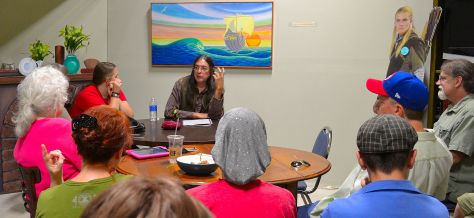Surfing the websites of Tolkiendom, I often encounter negative critiques of Peter Jackson’s Middle-earth films. The most frequent complaint focuses on Jackson’s lack of fidelity to Tolkien’s texts. To attract a global mega-audience, Jackson and his colleagues extensively re-envisioned Middle-earth, deleting scenes, elevating action adventure over enchantment, amplifying and inserting women, and repositioning textual materials. I have much enjoyed Peter Jackson’s cinematic visits to Middle-earth, but I sympathize with those who find some of Jackson’s revisions debatable and even troubling.
In one respect, however, I appreciate Jackson’s choice to modestly revise Tolkien’s storytelling. This has to do with the characterization of orcs. Tolkien deliberately rooted his monstrous orcs in the social soils of race, as he wrote in 1958: “They are… in fact degraded and repulsive versions of the (to Europeans) least lovely Mongol-types.” In contrast, Peter Jackson’s fantasy orcs do not seem much indebted to the real world traditions of race.
On the spectrum of Tolkien critics versus Tolkien fans, a defining divide centers on racial messaging. For those who find Middle-earth little to their liking, the evident manifestations of race offer a ready target for complaint. According to this position, Tolkien’s linkages of skin color and moral symbolism come across as racially insensitive, if not racist. On the other hand, fans of Tolkien know that he despised Nazi racialism. They see his diverse fantasy races uniting to defeat evil in the world, and they appreciate his moral vision of diversity achieving transcendent community. The interlocked circles of fandom and scholarship affirm the idea that Tolkien stood squarely against racism. Except… well, there is the problem of orcs.
In a 2003 study of Tolkien and miscegenation, Sandra Straubhaar mounted a defense of Tolkien, but acknowledged the problem of his slant-eyed orcs: “Tolkien seems to have exhibited a kind of racism perhaps not unremarkable in a mid-twentieth-century Western man[.]” A year later Anderson Rearick proposed that Tolkien might have projected the nature of his orcs through the non-racial lens of biblical references to darkness and evil – a view he would doubtless modify in light of Tolkien’s comment on orcs as “Mongol-types.” In her 2010 book, Dimitra Fimi constructed a rather convoluted logic designed to blur and soften the harsh clarities of Tolkien’s racialized orcs. And in 2012 Michael Martinez asserted that Tolkien simply meant to reference Mongols; but he concluded that Tolkien’s “Mongol-types” may provide “the only clear evidence of racism in Tolkien’s fiction – in that he uses a racist stereotype for one of his fantasy races.”
Some critics similarly point to Peter Jackson’s Uruk-hai as overly racialized. But it is also notable that he chose to bestow upon his orc-folk diverse flesh-tones ranging from very white to very dark. In contrast, Tolkien refers to orc skin-coloration as “black,” while his half-orcs are all “sallow-skinned” – none fall at the pale end of the spectrum. Tolkien intended for his orcs to embody repulsive “Mongol-types,” and when we study the evolution of his orcs, we can indeed see what he meant. He meant race. To formulate insights about what this signifies, it is important to contextualize Tolkien in history, to identify the likely cultural influences that illuminate what he meant by “Mongol-types.”
In my book, Tolkien in Pawneeland, I set forth detailed textual comparisons to show how Tolkien made use of Skidi Pawnee mythological materials. Tolkien would have seen the Pawnee storytellers as “Mongol-types” – as members of the same racial group that inspired him to colorize his orcs. But he wasn’t thinking of Pawnees when he racialized his orcs. It is apparent that he turned instead to Asia for inspiration.
Sitting down to visit Peter Jackson’s version of Middle-earth, I find his cinematic orcs an awkward fit, at best, to the narratives of race. But reading The Lord of the Rings, it is impossible to miss the racial tones of Tolkien’s orcs and half-orcs. If we are to understand what race signifies in our world and how it has shaped our lives, we must inquire into the reach of its teachings. And to make sense of Tolkien and race, we must delve into what he meant when he said that his orcs comprised a “degraded” version of the “least lovely Mongol-types.”
Considering how the teachings of race made their way into the making of Middle-earth, I have been fortunate to discuss my work with many interested friends and colleagues – I read an early version of my research in September 2014 before a gathering of the Grey Havens Group of Colorado. On April 25 I will read a new version of this research at Real Myth and Mithril, a special symposium organized by Grey Havens. The abstract of my paper can be found on the Grey Havens blog: The Least Lovely Folk March Into Real Myth


[…] For more on Echo-Hawk’s paper, visit Pawneeland: The Least Lovely Folk of Middle-earth […]
Yes, Tolkien’s racism certainly was not unusual back in the early 20th century, but I am happy we are discussing it now!